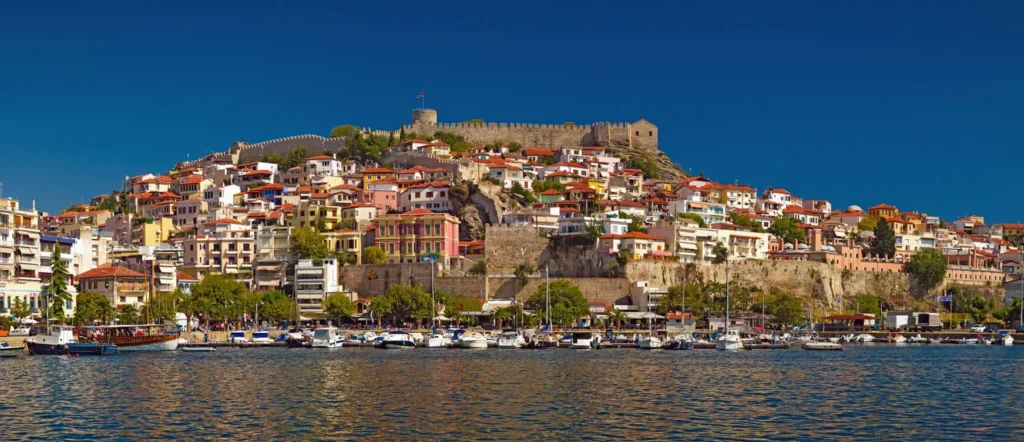Courtesy of the Greek National Tourism Organisation www.visitgreece.gr
The city of Kavala is situated on a hillside along the enchanting Aegean coast, serving as a captivating cultural crossroad between the East and West. It offers a remarkable array of attractions, exceeding all expectations for an ideal destination. From majestic mountains to inviting beaches, from picturesque cityscapes to awe-inspiring vistas, Kavala boasts a rich tapestry of experiences. Its historical significance is evident through the presence of significant monuments and sites, while the local cuisine delights with its delicious offerings.
Kavala’s coastal shores are a treasure trove waiting to be explored. Whether you seek secluded beaches with crystal-clear waters or vibrant spots bustling with activity, you’ll find something to suit your preferences. Enjoy thrilling water sports activities, followed by the pleasure of savoring delectable local dishes at a charming seaside taverna. The city’s enduring importance over the years can be attributed to its strategic location next to the historic Egnatia Way and its bustling port, which facilitated connections and trade between various civilizations.
Explore Kavala’s Old Town, starting your tour from the Panagia neighborhood, also known as Palia Poli. This historic area features narrow streets and traditional Macedonian-style buildings. Dominating the landscape is the 15th-century Castle, erected after the destruction of the Byzantine acropolis in 1391. The Castle offers stunning views of the sea and the town and serves as a venue for cultural events. Another must-visit is the historical Imaret building, donated by Mehmet Ali, a native of the city who later became an Egyptian ruler. Originally a seminary-poorhouse, it transformed into a refugee house and is now a luxury hotel.
A short distance away, you’ll find a square with the bronze statue of Mehmet Ali, placed between his family house, an elegant Ottoman-style building with a garden, and the church of Panagia (built in 1965). Don’t miss the Khalil Bey mosque and the 17th-century seminary (medrese) during your exploration. Follow streets like Isidorou, Anthemiou, and Lambrou Kotsoni to reach the imposing Aqueduct, locally known as Kamares. With its 60 arches standing 25 meters tall, this landmark dates back to 1550 and later in the 19th century Mehmet Ali repaired it to provide water supply to the city.
Moving on to the main city, you’ll encounter neoclassical buildings and tobacco warehouses, reflecting Kavala’s bourgeois past. The tobacco Museum on Konstantinou Paleologou Street displays historic photographs of tobacco workers from the area’s past. Start your journey at Eleftheria Square, then follow Megalou Alexandrou pedestrian street leading to Kapnergati square, where numerous cafes and bars await. Explore the Museum of the National Tobacco Organisation and adjacent tobacco warehouse to learn about the city’s tobacco production history.
During your stroll by the city’s port, you can capture the beauty of moored sailboats, fishing boats, and contemporary buildings. Enjoy a meal at one of the fish tavernas or relax in cafes along Ethnikis Antistaseos seaside street. Notable structures in the Municipal Park area include the City Hall, a miniature Hungarian tower, the Great Club building, the Wix Building (now housing the Municipality’s offices), and the Tokos building, which houses the Kavala-Thassos Ephorate of Antiquities.
The Lighthouse district on the Panagia peninsula offers breathtaking views, especially during sunsets. Here, you’ll find three lighthouses to explore: the green lighthouse on the pier, the coastal wall’s red lighthouse, and the larger lighthouse district.
Beyond the Old Town, Kavala boasts picturesque ports and beaches, such as Palio, Nea Iraklitsa, and Nea Peramo. For a historical experience, visit the UNESCO World Heritage Monument, the archaeological site of Philippi, and explore the Byzantine monasteries, traditional villages, and lush nature of Mt Paggaio.
Additionally, don’t miss the charming neighborhoods of Agios Ioannis and Agios Pavlos, known for their appealing architecture and churches. Before leaving the city, make sure to visit the churches of Agios Syllas and Agios Panteleimonas at the entrance of Kavala. And for a glimpse of the area’s prehistoric heritage, the Archaeological Museum showcases fascinating finds from Kavala and its surrounding regions, including Amfipoli and Aisyme.
Courtesy of the Greek National Tourism Organisation www.visitgreece.gr

